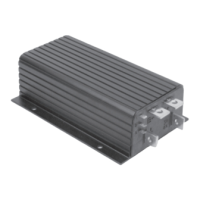19
Curtis PMC 1204/1205 Manual
If you prefer dynamic braking to freewheeling, you can install a
dynamic braking resistor. The motor generates power in slowing down
the vehicle; the dynamic braking resistor dissipates this power as heat.
The amount of braking torque is determined by the resistance, and is
proportional to the vehicle’s speed. The resistor gets hot and must be
sized and mounted accordingly. (NOTE: The size of the motor and the
amount of braking desired are factors in determining the appropriate
dynamic braking resistor; contact Curtis for guidelines.) The N.O. and
N.C. contacts of the forward/reverse contactors must be wired as shown
in Figure 17 or this scheme will not work.
Note that in all the PM motor wiring schemes shown (i.e., Figures
15–17), the forward/reverse switch is double-pole, double-throw (DPDT)
center-off. In addition to operating the forward/reverse contactors, the
switch turns on the controller’s KSI and main contactor when forward or
reverse is selected. By turning off the KSI in the neutral position, the
controller’s HPD feature will inhibit the controller output if the forward/
reverse switch is changed with the pedal depressed. While this will not
prevent the braking effect of reversing direction with the vehicle moving,
it will at least keep the motor from being driven in the opposite direction.
A forward/reverse interlock module (Curtis PMC p/n 1301) is
available for 24–36V models to prevent reversing direction while the
vehicle is in motion. This module allows the contactors to be reversed
only when the motor’s back EMF has come down to a preset level.
Contact Curtis for Application Notes providing further information.
WIRING

